Dive Sites from 0 to 25 meters
In Mauritius, due to the good visibility and diving conditions, the local Federation (MSDA) allows CMAS Level 1 divers (CMAS 1 STAR) to dive to a maximal depth of 25 meters .
The FFESSM Level 1 divers are not forced to go that deep if they don't want; they should just mentioned it during the briefing..
PADI Open Water divers are allowed to dive down to 18 metres. If they wish to go deeper, they can take a quick course to pass the CMAS 1 certification. For more information: contact us!
NEAR ZONE - Trou aux Biches and Grand-Baie
1. Coral Garden (15 to 19 meters)
-
Navigation time: 35min
-
A coral site with abundant life: Flying gurnard, nudibranchs, yellow-edge lyre tail, angelfish, butterfly fish, surgeon fish, triggerfish, wrasses, and more. On this dive it is not rare to observe the rare weedy scorpionfish. This is a favourite dive for photographers
-
Video interest: ***
-
Photo interest: ***
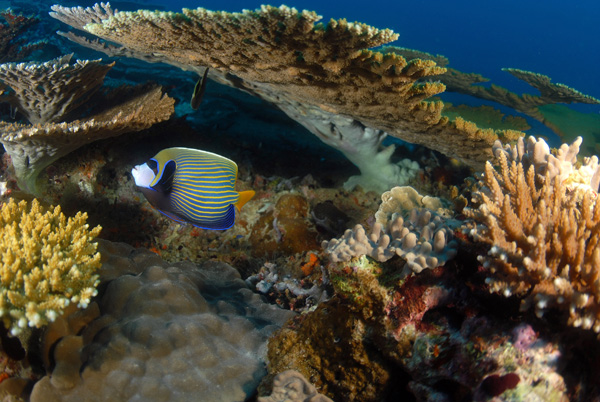
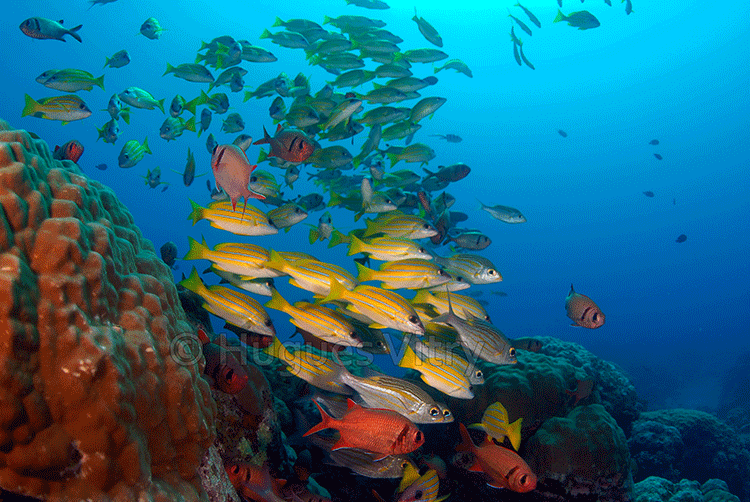
Emperator angelfish under table coral
2. Water Lily Reef (11 to 20 meters)
-
Navigation time: 15min
-
Another coral site with abundant and varied life: rich in macro life and reef fish, nudibranchs, yellow-edge lyre tail, angelfish, butterfly fish, surgeon fish, triggerfish, wrasses, and more. This is a favourite dive for photographers
-
Video interest: ****
-
Photo interest: ****


3. Pyramid Reef (9 to 20 meters)
-
Navigation time: 15min
-
North-East extension of Water lily Reef (too large to explore in a 1h dive) with the same characteristics.
-
Video interest: ****
-
Photo interest: ****


4. Déline Reef (10 to 20 meters)
-
Navigation time: 15min
-
Off Pyramid Reef, the reef continue to the North-East direction with the same coral reef and marine life types
-
Video interest: ****
-
Photo interest: ****
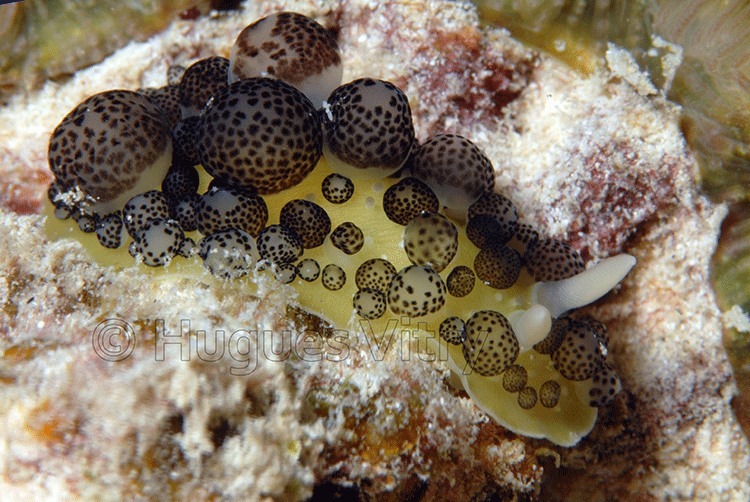

5. Holt's Rock (16 to 18 meters)
-
Navigation time: 15min
-
Enormous blocks of granite rock surrounded by coral and the usual reef wildlife form hiding places for titan triggerfish who come to say hello immediately the diver descends into the crowd of wrasse, parrotfish, angelfish, butterfly fish, yellow-edge lyre tails, triggerfish, clownfish and their host anemones, schooling snappers, scorpionfish, stonefish, and much more. But the crowning glory of this dive is the possibility it offers for encounters with giant morays at least two meters long.They are curious to the point that they come out to meet you and actively want you to touch or at least pay attention to their presence.
-
Video interest: *****
-
Photo interest: *****


Stacey and the Javanese Moray
6. Aquarium of Grand Baie (10 to 14 mèeters)
-
Navigation time: 30min
-
Large reef with a central channel on white sand bank. Abundant reef fish (juveniles), several types of morays, lion fish, scorpion fish, stone fish, octopus and some rare fish. This site is popular to underwater photographers! An easy dive for beginner divers (level 1) and ideal for refresher dives
-
Video interest: ****
-
Marco Photo interest: *****
7. Moray Reef (Merville Patches; 11 to 13 meters)
-
Navigation time: 30min

Locally called the megamouth moray (rare) Yellow tail moray-eel
-
A few scattered reefs on a white sandy bottom with a spectacular turquoise ambiance. Shoals of juvenile fish, numerous species of moray, lionfish, scorpionfish, stonefish and young octopuses, as well as a few varieties of fish that are either endemic or rare. This is a site much appreciated by underwater photographers, by level 1 beginner divers looking for an ideally tranquil site and more experienced divers wanting a refresher dive to get back in trim at the start of their holiday.
-
Video interest: ****
-
Marco Photo interest: *****
8. Water Lily and Emily Wrecks (20 to 25 meters)
-
Navigation time: 15min


Water Lily Wreck school of blue stripe snappers
-
Two barges sunk in 1981 (Water Lily) and 1982 (Emily) on a level sea bottom whose white sand makes the site attractively luminous whatever the weather conditions at the surface. The two wrecks have been colonized by large quantities of wildlife – Bengal snappers, surgeon fish and butterfly fish – along with yellow mouth morays, dozens of lionfish, red crabs, stonefish, shellfish and nudibranchs. Dives are particularly good fun on this site because the fish are relaxed and curious around the divers.
-
Video interest: ****
-
Photo interest: ****
9. Poison Reef (19 to 27 meters)
-
Navigation time: 30min


-
Video interest: ***
-
Photo interest: ***
10. Turtle House Reef (10 to 22 meters)
-
Navigation time: 30min


Barracuda in a swarm of fusiliers diver and green turtle
-
A site with a series of scattered reefs at depths between 10 and 26 meters. The turtles on this reef are mainly green turtles (Chelonia mydas, see photo) of impressive size, but hawks bill turtles are also found here. The turtles settle under large rocks and, if they are not disturbed, will rest there, quietly dozing
It is extremely important that divers follow the instructions they are given and not try to touch or, especially, hold on to or chase after turtles. It is also advisable to avoid finning above a resting turtle – turtles should be approached from the side and a little ahead, avoiding a direct frontal approach or lifting sand from the bottom. It is particularly important to avoid any approach from behind.
Turtles are amphibious, which means they need to return to the surface to breathe from time to time and if they are kept underwater they can drown!
Some turtles are more comfortable around human beings and allow themselves to be approached without difficulty while they are feeding on the bottom.
-
Video interest: **
-
Photo interest: **
11. Stella Maru Wreck (18 to 24 meters)
-
Navigation time: 15min


Stella Maru Wreck & Trigger fish and diver with Stella Maru Wreck in the background
-
The Stella Maru is an old Japanese trawler sunk in December 1987 at the request of the MSDA as an artificial reef to attract marine wildlife. The wreck sits on a flat sandy area in the middle of a series of coral reefs and has been colonized by red toothed triggerfish, trevallies and the whole range of the usual species of reef fish (butterfly fish, damsels, banner fish, surgeon fish, etc.). It is also home to two giant morays, one two meters long which has set up house in one of the wrecks chimneys, along with two pretty cleaner shrimps Stenopus hispidus whose task is to keep it free of parasites. Around the Stella Maru photographers will find stingrays, barracuda, leaf scorpionfish, lionfish, a magnificent group of sea anemones plus clownfish and domino damsels and an occasional group of stingrays. Shellfish, nudibranchs, small geometric morays and octopuses are also found at this site. There is so much to observe on and around the wreck that divers never tire of this site.
The Stella Maru was involuntarily reawakened from her slumber by cyclone Dina in January 2002: after being scuttled in 1987, the wreck had been lying on its side but during the hurricane the swell was so massive even at a depth of 24 meters that the wreck was lifted and set down vertically on its keel.
-
Video interest: *****
-
Photo interest: ****
12. Caravelle (13 to 30 meters)
-
Navigation time: 10min
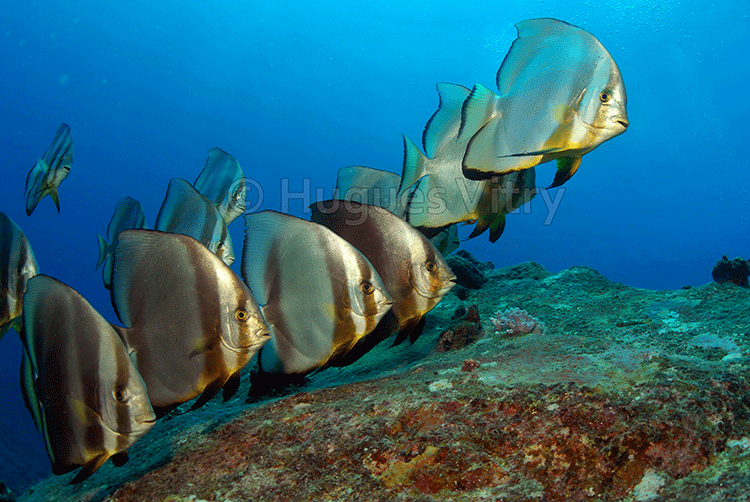

School of Batfish in Caravelle
-
This site has a northern plateau starting at 13 meters and descending in stages to 20 meters and then gradually to 30 meters. It has a large population of batfish - (see photo) with three main species:
- Orbicular batfish (platax orbicularis)
- Platax de Boers (platax boersii) - Assez rare dans l'océan indien
- Platax à longues nageoires (platax teira)The site is sometimes subject to strong currents carrying dense shoals of voracious barracuda and trevally. Emperor, semicircular and three spot angelfish are common on this site.
On some days rays, young shark and turtles are to be seen here.
This is a perfect site for qualified divers of all levels if they are comfortable with currents
-
Video interest: ***
-
Photo interest: ***
13. The 3 anchors (13 to 18 meters)
-
Navigation time: 15min
-
Three beautiful anchors from the 17th century, a few meters apart from each other on a site just outside the pass of Trou aux Biches. Small walls with reef fish and sometimes frog fish on the anchors.
On this dive site, divers can observe more than a dozen green turtles at rest above small walls and lava rocks covered wit coral formations.
It is not rare to encounter one or 2 touristic submarines in operation at depth during the dive. It is a funny experience for both, the submarine passengers and for the divers.
-
Ideal for night dives.
-
Vidéo interest: ***
-
Photo interest: ***
14. Lost Anchor (18 to 25 meters)
-
Navigation time: 15min
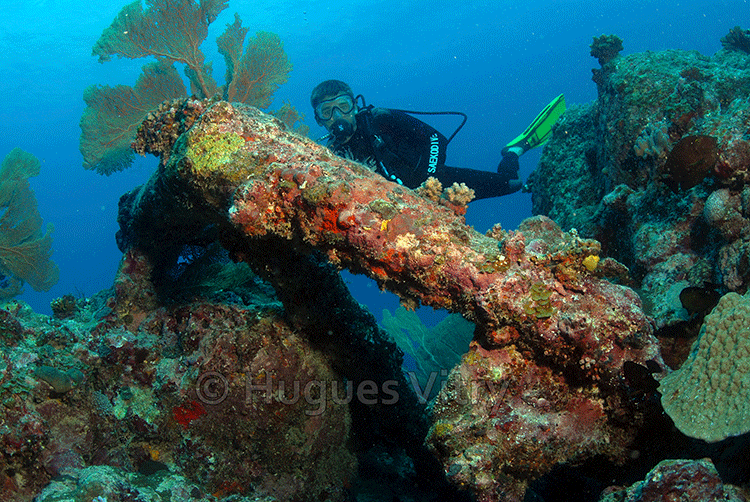

Nice 16th century Anchor & diver on Lost Anchor dive site
-
Not far from Peter Holt's Rocks towards the west lies a large 17th century anchor in a crevice on top of a pinnacle. the wooden shaft as long been destroyed by decomposition and time and one can still see the iron clips that use to keep it on the anchor somewhere on the sea floor.
On this dive site there are school of fusiliers and bluefin jacks and sometimes eagle rays and dogtooth tunas. In the crevices of the reef below live two huge Javanese morays. some giant scorpionfish and the deadly stonefish can be seen and for expert eyes a couple of anglerfish hides around on this reef.
-
Video interest: ****
-
Photo interest: ****
15. Cratère (11 to 25 meters)
-
Navigation time: 15min


-
This dive site is at the entrance of Mon Choisi pass. Beautiful underwater landscape with big boulders and a crescent-like small wall that makes it look like a part of a crater.
School of juvenile batfish, leaf fish, sometimes frogfish clown fish and anemones and other reef fish.
-
Video interest: ****
-
Photo interest: ***
16. Whale rocks or Hidden reef (11 to 26 meters)
(The amphitheater)
-
Navigation time: 25min


-
Whale rocks dive site is a medium size wall just out of the Canonniers Point; like most dive sites situated on a point, the place is ideal for passage of big fish and sometimes not accessible because of currents. Ideal for drift dives.
Beautiful landscape with lots of gorgonian and glass coral.
-
Video interest: ****
-
Photo interest: ***
MIDDLE ZONE - Northern Islands
(Coin de Mire or Gunner's quion Island)
17. Coin de Mire - Confetti Bay (3 à 16 mètres)
-
Navigation time: 60min
-
This dive site is situated on the southern side of the Coin de Mire Island (Gunner's Quionn), not far from the wreck of Djabeda.
A multitude of small pinkish soft coral covering the sea bed and rocks is an enchantment for the diver. Many reef fish on the reef and then the reef slopes down to around 25 meters (80 feet).
It is better to stay on the shallower part of the reef.
Sometimes eagle rays, dog-tooth tunas and turtles can be observed on the reef.
This site is popular to underwater photographs!
-
Video interest: ****
-
Photo interest: ***
18. Coin de mire-Head (9 to 22 meter)
-
Navigation time: 50-60min
-
Site on the south western side of the Coin de Mire island. The dive runs along the southern side from west to east until the reef ends into a drop off. Massive amount of fusiliers sometimes hunted by blue jacks, big parrotfish and school of rudder fish. Barracudas, and dog-tooth tuna not uncommon on this site.
If the sea is calm, there is a beautiful cave no deeper than 6 meters that runs 30 meters or more under the island which can be explored. Only for divers Level 2 or more, equipped with torch.
This site is popular to underwater photographs!
-
Video interest: ***
-
Photo interest: ***
19. Coin de mire- The Walls (9 à 30 meters)
-
Navigation time: 50-60min
-
Site on the South-West side of Coin de Mire. The dive path runs along the southern side of the island from West to Est to finish at the beginning of the Walls. Massive amount of fusiliers and big parrotfish. Barracudas, and dog-tooth tuna not uncommon on this site.
If the sea is calm, there is a beautiful cave no deeper than 6 meters that runs 30 meters or more under the island which can be explored. Only for divers Level 2 or more, equipped with torch.
This site is popular to underwater photographs!
-
Video interest: ***
-
Photo interest: ***
FAR ZONE - Northern Islands
(Round Island and Snake Island region)
20. Nab Reef or Banc Rouge(surface down to 77 meters)
-
Navigation time: 2h00- 2h30
-
This is a very attractive wall descending vertically to a sandy plain with scattered rocks among which rays, angelfish (e.g. semicircular angelfish), groupers and sharks go about their business.
This is one of our most attractive dives but because of its proximity to Ile aux Serpents (Snake Island) in the North, it can only be reached in summer (October though April) with good weather conditions.
-
Video interest: ****
-
Photo interest: ***
21. The Blinders - Banc rouge (12 - 20 meters)
-
Navigation time: 2h00- 2h30
-
Beautiful reef with corals and a nice landscape. Presence of juvenile shark and fish in open water.
At the bottom, reef fish and sting rays
This dive site is very far from our base; because of its proximity to Ile aux Serpents (Snake Island) in the North, it can only be reached in summer (October though April) with good weather conditions.
-
Video interest: ****
-
Photo interest: ***
22. Batfish Alley - Banc rouge (20 meters)
-
Navigation time: 2h00- 2h30
-
A nice ballade on a site rich in fish of all sorts, crystal clear water; the dive ends in a dead-end channel with boulders where Batfish are common.
Yet another site worth seeing but very far and only accessible in summer (October though April) with good weather conditions.
-
Video interest: *****
-
Photo interest: ****
23. The Shark's Cathedral - Nab Reef (14 à 22 mètres)
-
Navigation time: 2h00 - 2h30


-
One of the nicest dive in Mauritius! Crystal clear water and underwater reliefs with pics and pinacles covered with hard and soft corals. An rich underwater life with jacks, tuna and sharks depending on the currents
This site is popular to underwater photographs! Only for experienced divers with good diving skills.
This dive site is very far and only accessible in summer (October though April) with good weather conditions..
-
Video interest: *****
-
Photo interest: *****
Diver exploring the surroundings of The Shark's Cathedral
24. Shark Basin (de 12 to 34 meters - limite of 20 meters for Level 1)
-
Navigation time: 2h00 - 2h30


-
This sensational dive and undoubtedly the most famous dive in Mauritius for many years: located just off the Northern Islands, in early morning and in season this Shark basin provide the opportunity to observe sharks in groups of between 5 to more than 40(!) there to enjoy the refreshingly oxygenated water.
To get to the basin, the divers have to follow a long alley where very often in the early morning some eagles rays are there to get cleaned and sometimes we can observe a young hawk-bill turtle on the reef.
This is also a sort of kindergarten for juvenile sharks.
IMPORTANT NOTE: EVEN IF THIS DIVE IS NOT DEEP, IT IS STRICTLY RESERVED FOR EXPERIENCED DIVERS WITH GOOD UNDERWATER BUOYANCY CONTROL - BEGINNER NOT ACCEPTED! (Prerequisite: at least 25 logged dives in open water and experience in drift dive required.)
-
Video interest: *****
-
Photo interest: *****
Juvenile sharks in the Shark Basin
25. Pigeon's Rock (ex-shark pit)
-
Navigation time: 1h30
-
This is a sensational dive and undoubtedly the most famous in Mauritius for many years: located just off Rocher aux Pigeons (Pigeon Rock) Island, North of Coin de Mire Island, in early morning and in season the Shark Pit provided an opportunity to observe sharks in groups of between five and more than 40 (!); They enjoy there the refreshingly oxygenated water. Unfortunately, because it was dived by too many centres without consideration for the conditions, the sharks abandoned the Pit for other locations. At the exit of the Pit, an attractive underwater exploration can offer nice surprises.
-
Video interest: *****
-
Photo interest: *****






